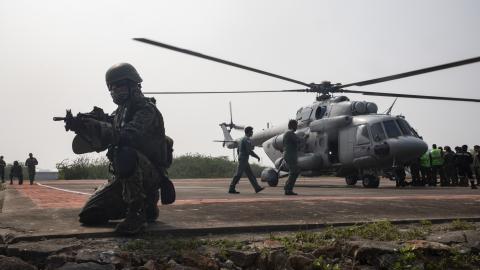India’s Union Budget 2024 was published. There are many discussions about how to allot defence budgets. For example, how to balance between “capital” for new equipment and “revenue” for salary, maintenance, etc. How should we improve defence development capabilities? How should we maintain the defence industry? How much pension should the government pay for soldiers?
These issues are easier to solve if we can first identify defence priorities. Thus, in this article I focus on three steps: 1) identifying historical lessons that can guide our modern priorities, 2) deciding on our priorities based on the current global military situation, and 3) evaluating the situation in Japan based on these priorities.
1. Identifying historical lessons to guide our current priorities: What kind of army does the country want to establish? That is the priority that should guide defence allocations. A useful example here is Germany after WWI. Under the Treaty of Versailles, Germany’s army was restricted. They could not possess armies bigger than 100,000 members, and possessing tanks, airplanes, and submarines was prohibited. Despite these conditions, the German army occupied more than half of Europe two decades later during WWII. How was that possible?
Simply said, the Germans at that time identified their priority clearly. And guided by that clear priority, they used their resources very effectively. For example, they gathered and educated 100,000 people (including 4,000 officers) to become high officer-level leaders. Due to these high-level leaders, it was easy for Germany to form a 3,000,000-man army a short period later. At the same time, Germany developed completely new tactics based on the integration of many tanks, bombers, and howitzers connected by a reliable communication system. To research new tactics and train soldiers, Germany secretly collaborated with the Soviet Union. Therefore, when the Nazis took control of Germany, they got not only the government but also a strong, well-developed army. This was a typical example of how to allot a military budget. When the purpose is clear, allocation of finances is straightforward and effective.
2. What are the priorities under the current global military situation? What are the strategic priorities in the current world? For example, Japan’s Self-Defence Force consists of 50,000 officers, 140,000 non-commissioned officers, and 50,000 soldiers. That is a large percentage of leading officers. Like the German army in the interwar period, Japan is focusing on expanding if they need to.
The lesson of Germany between WWI and WWII was repeated in 2020 between Azerbaijan and Armenia. The Azerbaijan army succeeded in integrating their traditional military tactics and new drone-forces tactics and defeated the Armenian armed forces. Therefore, like Germany and Azerbaijan, how to create the “infrastructure” for the army to win the next war will be an important matter. The lesson of Germany during the interwar period indicates that there were two types of infrastructure. The first one demands a long buildup period. The other type of infrastructure does not.
For example, educating high-skill officers, establishing a technological development base and its supply chain, researching new strategy and tactics, etc. demand time and investment. In the case of Germany, recruiting, educating, and training 100,000 members who could lead a 3-million-soldier army required a long lead-up. These types of priorities can be counted as infrastructure development. The army should be an attractive job for high-skilled people. Providing high salaries and high-level service is not wasting money if it forms a strong army that can win the next war.
Compared with recruiting, training, and compensating high-skilled officers, it is far easier to expand one’s armed forces. Germany was able to expand its forces to the 3-million level in a short period because they had a solid base of 100,000 officers. Thus, in peacetime, size is not the priority. Quality is the priority.
Developing new weapons demands a lead time of 10-15 years. In this case, developing the infrastructure of a strong technological base is the priority. And if this base is in place, new weapons can be created at a very rapid pace. For example, in the Falklands War, the British needed an Airborne Early Warning (AEW) aircraft. The UK was able to develop one in 11 weeks using helicopters.
Although that was not quickly enough to deploy them in the Falklands War, this illustrates that the UK has the technological sophistication to adapt pre-existing technologies to unexpected needs as they arise in combat. Therefore, establishing a technological base requires time, but having that base can solve small problems in a war very quickly.
How about defence production? The period of production is determined by the type of weapon. Warship production generally requires five years. But in the case of Britain in WWII, Prime Minister Winston Churchill pointed out interesting facts based on his experience. In his book World War II, he said that there was a four-year process for expanding defence production. During the first year, the factories did not produce anything. During the second year, the factories produced a little. During the third year, they produced a lot of weapons. And during the fourth year, they produced a flood. Recent examples back up this theory. In 2023, European countries jointly decided to order one million ammunitions to Ukraine by March 2024. But by March 2024, European countries expect the bloc to have reached around 52% of its objective with over half a million deliveries. In this case, March 2024 will be just the end of the second year of Russia’s aggression. So Churchill’s theory is still applicable in the 21st century.
Indeed, we cannot ignore the power of international cooperation. For example, the Allies won WWII, but the supply chain of weapons that the Soviet Union and the British depended on came from factories in the United States. The number of countries cooperating was a vital factor in winning that war. For example, in WWI, the winning side comprised 32 countries and the losing side consisted of only four countries. In WWII, 54 countries won against eight countries. And in the US-Soviet Cold War, 54 countries won against 26 countries. Now, in Ukraine, NATO’s supply chain and Russia’s supply chain are competing. Therefore, creating alliances and partners and sharing the supply chains of defence production is a vital part of success.
3. What is the ideal defence finance allocation? The lessons from WWI and WWII call for deciding on priorities when figuring out defence finance allocations. Developing quality requires a long period compared with developing quantity. It’s possible that the top priority is investing in humans. High-level officers and non-commissioned officers will give the military new tactics. New technology developed by highly trained scientists will also provide ideas for new tactics. To possess a strong defence capability, it will need to rely on human resources. We must remember the fact that both the country and the army are a group of humans.

















